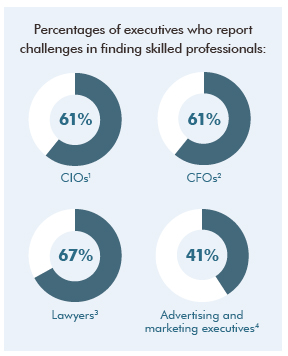Report: U.S. jobs in most demand in finance, accounting

 Job opportunities across the United States are mostly in the areas of finance and accounting, which during the 12-month period ended May 2016 registered a 99.5 percent employment level, according to a recent study by research firm Robert Half Technology.
Job opportunities across the United States are mostly in the areas of finance and accounting, which during the 12-month period ended May 2016 registered a 99.5 percent employment level, according to a recent study by research firm Robert Half Technology.
The “ Special Report: The Demand for Skilled Talent,” released Tuesday by Universia Puerto Rico, showed that the second-highest area of employment is in information systems administration, with a 99.4 percent demand.
Attorneys, legal assistants and paralegals are tied for second, followed by office and administrative support, with 98.4 percent of employability for the position of manager of administrative services. The area of marketing and creativity rounds out the list of sectors with the highest demand in the U.S., with designers being the most sought-after professionals in that area, with a 97.8 percent employment rate.
Robert Half Technology specializes in identifying hard-to-find candidates and matching them with appropriate jobs. The company compiled the latest research on trends in employment including data from the U.S. Bureau of Labor Statistics to produce the report. The document includes a list of employment rates for specific occupations of the most demanded sectors.
The report showed that between May 2015 and May 2016, 5.5 million jobs were available in the United States, which is an increase of 19 percent compared to the available amount two years ago. Employers plan to hire 5.2 percent more new grads from the class of 2016 than they did from the class of 2015, the report showed.
“Despite openings in the labor market, recruiters reported having difficulties in finding appropriate talent to fill vacancies,” the report stated. “The disparity is mainly seen in small businesses that have limited budgets to hire trained staff and compete with larger companies.”
However, retaining the best employees and offering certain advantages linked to working hours, schedules or flexibility, are strategies that companies with fewer resources can use to increase their competitiveness to acquire skilled professionals, the report noted.
The report recommended that employers reduce hiring times to achieve a greater recruiting success, because the best candidates do not wait long to confirm for employers to confirm or dismiss their application.
The report cited data confirming that 57 percent of workers said a long wait after the interview is the most frustrating stage of a job search, and 39 percent classified as a “long process” when recruiters take between seven and 14 days to decide. Also, 47 percent of workers said the interview is the determining factor in deciding whether a job meets their expectations.
Moreover, employers expect to interview candidates with appropriate skills to develop entrusted tasks. Recruiters confirmed in the study that their most sought-after skills are interpersonal relationships to work in teams (72 percent,) strategic thinking (71 percent,) and self-direction (66 percent.)
The study also showed that the demand for healthcare professionals with work experience vacancies represented 500,000 jobs between May 2015 and May 2016. Currently, health services constitute 17.5 percent of the U.S. GDP and are expected to reach 20 percent by 2025.
The biggest challenges facing the sector are declining care costs, improving patient experience and the management of compliance with established standards. In response to these challenges, health services are including in their payroll accounting and finance, revenue cycle specialists, administrative staff and specialized consultants.













